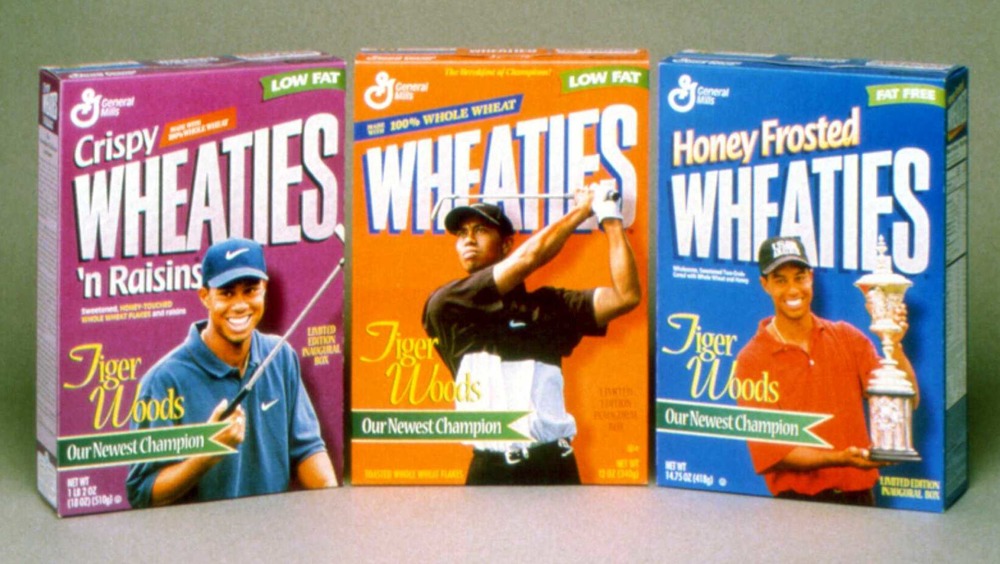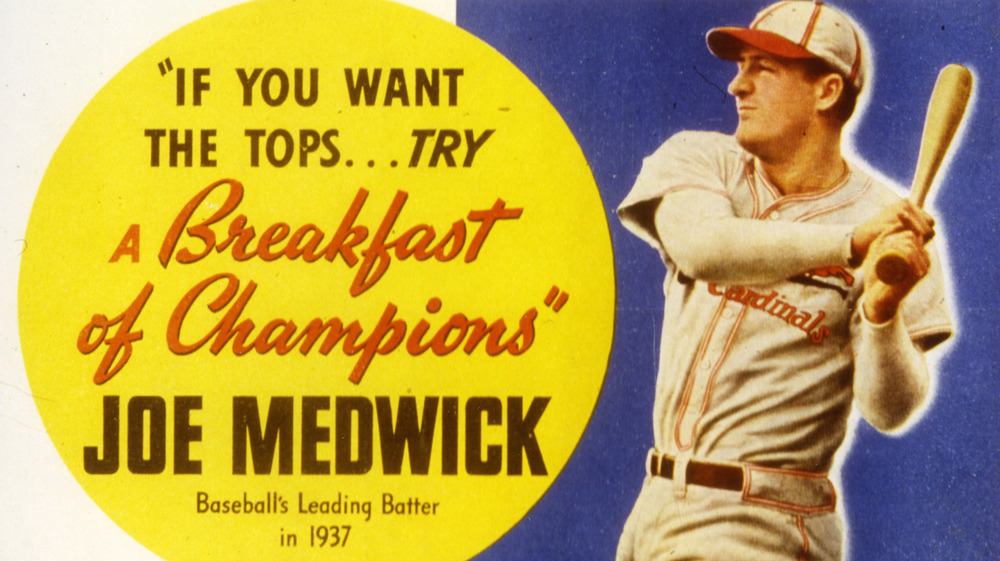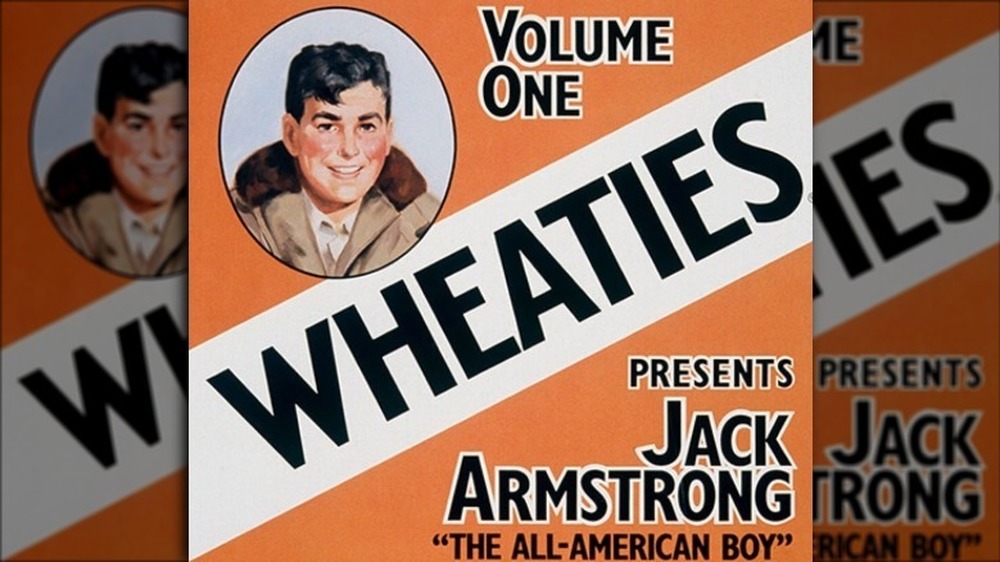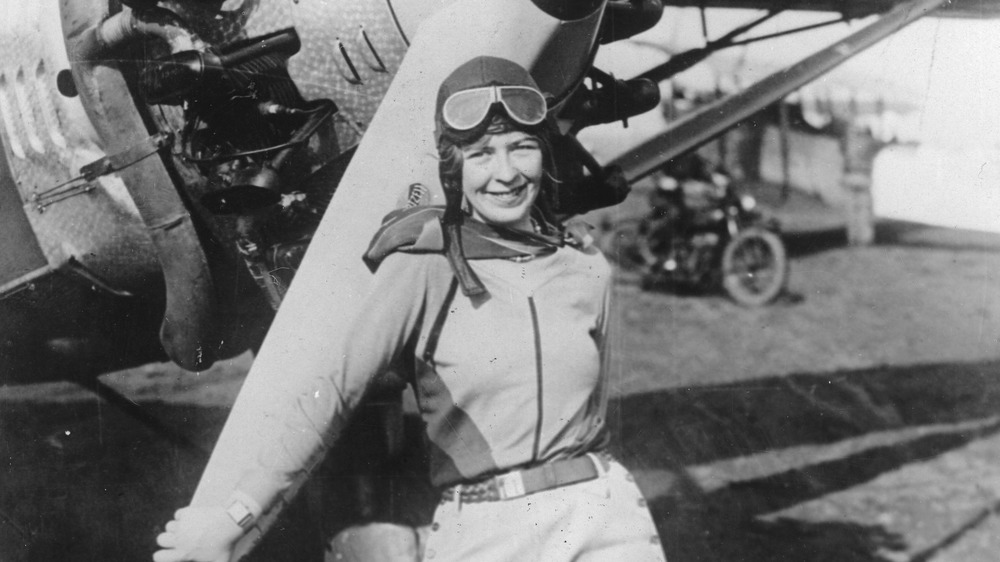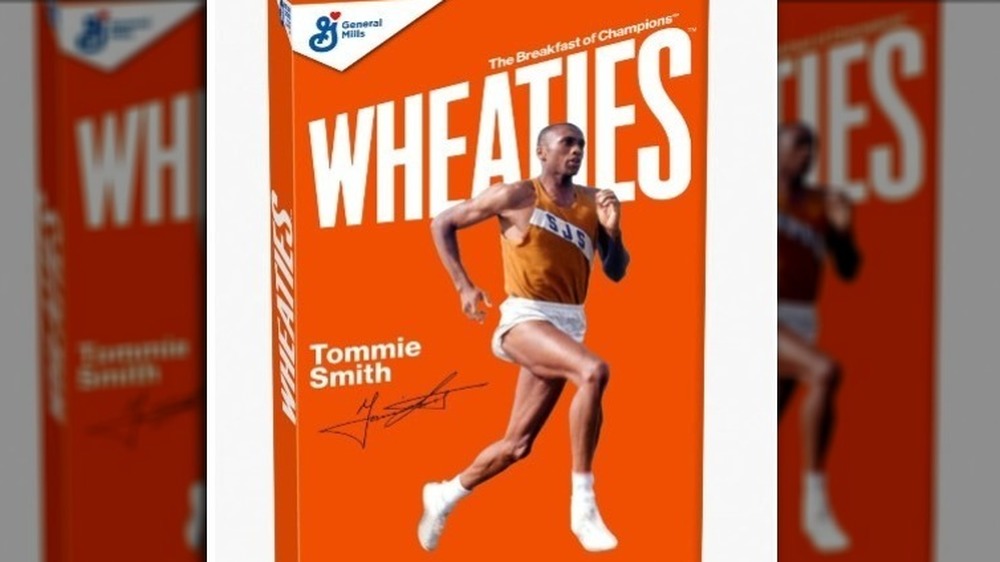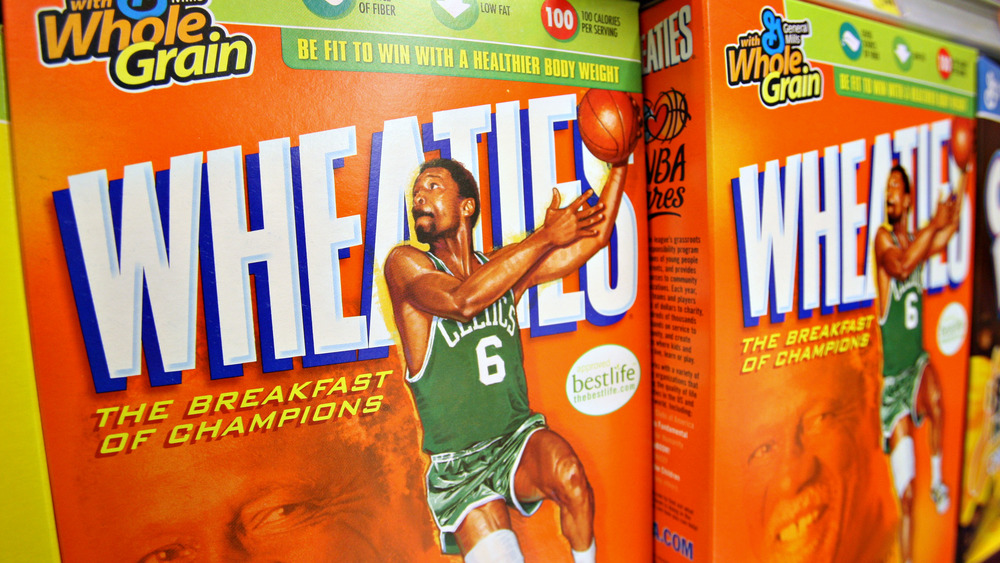The Untold Truth Of Wheaties
It's refreshing to see that 100 percent whole-grain Wheaties, which made our list of 10 breakfast cereals you should be eating, is still going strong, even at a point in time when breakfast cereals are taking their inspiration from such non-breakfast essentials as Little Debbie Oatmeal Creme Pies and Cinnabon cinnamon buns. Wheaties were created in 1921, when a Minneapolis health clinician accidentally spilled a bit of bran gruel on a hot stove and noticed how nicely it "crackled and sizzled" into a crispy flake, according to information provided by General Mills. The Breakfast of Champions, as it has come to be known, debuted soon after as "Washburn's Whole Wheat Flakes" – but not before the Washburn Crosby Company, which later became General Mills, tested out over 35 different combinations of wheat and bran to come up with the one that we now know and love as Wheaties.
Renamed "Wheaties" following a naming contest held by the company (which, remarkably enough for that day and age, was won by a woman, Jane Bausman, the wife of the company export manager), Wheaties later became the "Breakfast of Champions in the 1930s. That sports-centric tagline has been in continuous use since then and earned a trademark registration in 1936, according to trademark attorney Xavier Morales, writing for Secure Your Trademark, helping to make Wheaties forever synonymous with a nutritious start to the day and sports stars. But what might be the untold truth of Wheaties?
Wheaties has always cultivated strong ties with professional baseball
"From the start, Wheaties had an association with sports," according to trademark attorney Xavier Morales, writing for Secure Your Trademark, who explained that General Mills, which owned a Minneapolis radio station, was under contract to broadcast games played by baseball minor league team the Minneapolis Miners in exchange for billboard space at the team's home stadium. The first athlete to appear on a box of Wheaties was New York Yankees first baseman Lou Gehrig (via General Mills). Gehrig's Wheaties box debuted in 1934. Gehrig appeared two more times, posthumously, in 1992 and 1999.
It wasn't long after Gehrig's Wheaties box that Wheaties cemented its long-standing relationship with baseball. In fact, "by 1939, 46 of the 51 players selected for Major League Baseball's All-Star Game endorsed the product," according to General Mills. Other baseball players whose likenesses have graced the Wheaties box include Jackie Robinson, Babe Ruth, Jimmie Fox, and Barry Bonds(via Baseball Almanac).
The first face to appear on a Wheaties box wasn't an actual human
Although Lou Gehrig was the first athlete to appear on a box of Wheaties, his wasn't the first face, according to General Mills. That honor goes to a fictional character by the name of Jack Armstrong. Jack Armstrong was the title character of a radio show, Jack Armstrong, The All-American Boy, which was about a high school student (Jack) and his two friends, Betty and Billy Fairfield, who always happened to find themselves in the midst of some adventure or another.
"One of the first and most memorable juvenile adventure shows," in the words of the Radio Hall of Fame, the show debuted on CBS Radio in 1933 and ran until 1950. Jack Armstrong's illustrated likeness appeared on the Wheaties box in 1934, before General Mills came up with the genius idea of using actual human role models to advertise their 100 percent whole grain cereal.
The first woman to appear on a Wheaties box wasn't exactly an athlete
The very first woman to appear on a Wheaties box wasn't even an athlete, unless you consider piloting an airplane to be a sport (and arguably, you probably could). That woman was aviator Elinor Smith (via General Mills). Born in 1911, Smith achieved fame in 1927 for becoming the youngest licensed pilot (male or female) in the world, according to Cradle of Aviation Museum and Education Center. Smith was just 16 at the time, but she was 23 in 1934, when she turned up on the Wheaties Box, following baseball's Lou Gehrig.
Other women who found their way onto the Wheaties box include Olympic gold medal-winning gymnast Mary Lou Retton, Olympic skier and winner of four World Cups Lindsey Vonn, and Olympic gold medal-winning gymnast Sarah Hughes (via USA Today). More recently, in 2019, tennis pro and star of one of the most popular 2019 Super Bowl television commercials Serena Williams finally got her Wheaties box. "I have dreamt of this since I was a young woman and it's an honor to join the ranks of some of America's most decorated athletes," Williams said in a statement on the General Mills blog (via USA Today).
Athlete Tommie Smith finally gotten his Wheaties box
"Remember... you are not merely eating cereal when you pour a bowl of Wheaties," General Mills has stated. "At that moment, you are sharing in the 'Breakfast of Champions' with many of the most legendary athletes in sports history." As of 2021, that finally includes Tommie Smith, who earned himself an Olympic gold medal in the 200-meter sprint in Mexico City in 1968, which is what Smith's 2021 Wheaties box commemorates. The only question is — what took so long?
"We're celebrating one of the original activist athletes," General Mills explained in a statement on the Wheaties website, making reference to the historic moment when rather, than placing his hand over his heart as the national anthem played during the Olympic gold medal ceremony, Smith bravely bowed his head and raised his fist in the name of civil rights and racial equality. Smith's act of bravery promptly got him, along with fellow peaceful protestor, bronze medal-winner John Carlos, ejected from Olympic Village.
Not all of Wheaties' marketing campaigns were so successful
General Mills has made a number of truly inspired decisions with regard to marketing its 100 percent whole grain Wheaties. For example, in 1958, the long-overdue decision was finally made to put the athletes on the front of the box (via General Mills). Prior to the Wheaties box featuring Olympic pole vaulter Bob Richards on the front, Wheaties' athletes had always been relegated to the back of the box. Richards also became the brand's first spokesperson. By 2016, Wheaties had featured six more official spokespersons: Olympian athletes Bruce Jenner and Mary Lou Retton, football great Walter Payton, tennis great Chris Evert, golf's Tiger Woods, and basketball mega-legend Michael Jordan.
Speaking of Jordan, another of General Mills' most-inspired marketing campaigns was "Eat your Wheaties." The tagline exploded into popular culture in 1991 when basketball legend Michael Jordan told the world, "I better eat my Wheaties."
Somewhat less successful was the decision, made in the early 1950s, to try to market Wheaties to children by tying the cereal to the Lone Ranger and the Mickey Mouse Club. Although more kids were eating Wheaties, it wasn't enough to make up for all the adults who suddenly lost interest. In 1956, and not a moment too soon, Wheaties went back to its athletic roots.
